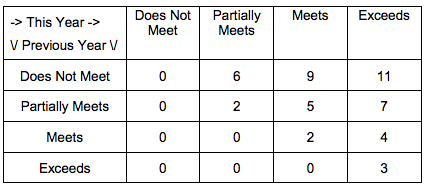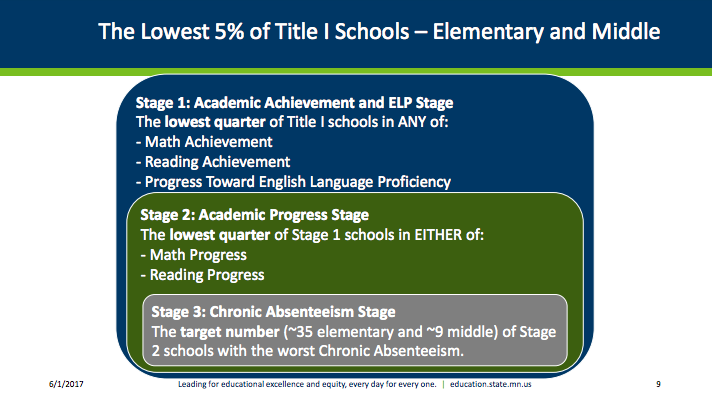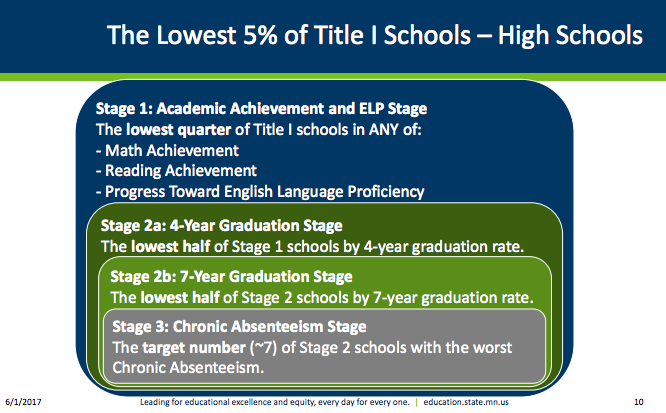This post is the fourth in our series, (see earlier posts from June 2016, Sept. 2016, and Dec. 2016) on the progress that the Minnesota Department of Education (MDE) has made developing the state’s new accountability plan, as required under the 2015 federal Every Student Succeeds Act (ESSA).
Last week, MDE’s ESSA Accountability Committee had their last meeting regarding their recommendations for state’s accountability plan. Over the course of ten months, the Accountability Committee met thirteen times to discuss the different components of the plan. Some of the primary topics of discussion were the state’s measures of school quality and student success (SQ/SS), graduation rates, academic growth, the state’s goals for the academic indicators, and how the bottom five percent of schools will be identified for support.
A summary of what MDE has decided to include in the state accountability plan is below. MDE will engage in regional meetings throughout the summer of 2017, and will post the entire state accountability plan for public comment in early August. MDE will submit the accountability plan to USDE on September 18, 2017.
But First, What’s Happening With ESSA Nationally?
Since our last post, there have been a few, significant ESSA developments at the national level. In March, President Trump signed a bill that revoked the Obama Administration’s final regulations, which created the opportunity for states to use a dashboard approach to identify schools for support rather than a single summative rating (more on this later).
Additionally, in April and May, sixteen states and DC submitted their state accountability plans to the US Department of Education (USDE) for review.
SQ/SS Indicator: Consistent Attendance
As we’ve previously written, due to data restrictions, MDE is only able to currently use chronic absenteeism, or as they’ve renamed it “consistent attendance,” for the SQ/SS indicator.
However, MDE has indicated that, as they build their data systems, they want to include other SQ/SS measures in the future like social-emotional learning, college and career readiness, and student surveys.
Graduation Rates
Under the state’s current Multiple Measurements Rating (MMR) system, high schools are held accountable for their four-year, five-year, and six-year graduation rates. However, in the new ESSA accountability system, MDE has decided to shift and hold schools accountable for their four-year and seven-year graduation rates.
For the four-year graduation rates, ESSA requires that states only measure a public high school’s graduation rate for students with a “regular diploma,” meaning students who receive a high school equivalency (GED) or an adult diploma will not be included. Further, any public high school will receive support if less than two-thirds of their students graduate in four years.
MDE decided to switch to using seven-year graduation rates in order to be more inclusive of students with special needs and because it also includes the the five-year and six-year graduation rates.
Academic Growth: Switch From Z-Scores to Transition Matrix
Under the state’s current MMR accountability system, MDE uses a z-score model to measure a student’s academic growth in both reading and mathematics. In this model, a student’ growth target is created by looking at a cohort of students who performed similarly on the prior year’s MCA assessment. Each student’s growth target is then averaged across all of the school’s students to calculate a school wide measure of growth.
Even though the Technical Committee recommended keeping the z-score model, the commissioner and MDE decided to switch to measuring academic growth using a transition matrix, mostly based on the argument that a transition matrix is easier to understand than a z-score.
In a transition matrix, the possible scores are divided into proficiency categories. Students demonstrate growth when they move from a lower to a higher category and schools only receive credit for the students who move to a higher proficiency level or stay in their current level. The table below depicts the transition matrix based on the Technical Committee’s April 13th meeting.

Table 1. Matrix-based growth scores. To determine a student’s growth score, first find the row for their proficiency level last year, then find the column for their proficiency level this year. The cell corresponding to that row and that column contains their growth score for the year.
Statewide Long-Term Goals
ESSA eliminated the average yearly progress (AYP) and No Child Left Behind’s (NCLB) 100 percent proficiency goals. Instead, states are allowed to establish their own goals. MDE provided the following three goals at the last Accountability Committee meeting:
- Academic Achievement: A statewide average index of 90 for both math and reading, with no group below 85, by 2025. The index is calculated from a mathematical formula, based on both proficiency and growth.
- 4-Year Graduation Rates: A statewide average of 90 percent, with no group below 85, by 2020. This is the state’s existing goal.
- 7-Year Graduation Rates: A statewide average of 100 percent by 2025.
In order to create a statewide goal for English Language (EL) proficiency, MDE will do more stakeholder engagement during the summer.
Identifying Schools for Support: The “Funnel Approach”
One of the most significant changes that MDE has decided to make under the new ESSA accountability plan is to not apply a summative rating to individual schools. Under the current MMR system, schools are given one of five different, summative ratings—Reward, Celebration, Continuous Improvement, Priority, and Focus.
However, under the new ESSA plan, MDE will no longer give a school a summative rating. Instead, MDE will identify the bottom five percent of schools for MDE support using a “funnel approach,” with one approach for elementary/middle and another for high schools. MDE will use this approach to identify schools for support every three years.
The approach for identifying the bottom five percent of elementary and middle public schools for support is in three stages:
- Academic Achievement and ELP (Stage 1): Title I schools that are in the bottom twenty-five percent for at least one of the academic growth indicators—mathematics achievement, reading achievement, and/or progress towards EL proficiency—will move onto Stage 2.
- Academic Progress (Stage 2): Title I schools that are in the bottom twenty-five percent for either mathematics growth or reading growth will move onto Stage 3.
- Consistent Attendance (Stage 3): Consistent attendance will be used to identify about thirty-five elementary and nine middle schools for MDE support.

The approach for identifying the bottom five percent of public high schools for support is in four stages
- Academic Achievement and ELP (Stage 1): Title I high schools that are in the bottom twenty-five percent for at least one of the academic growth indicators—mathematics achievement, reading achievement, and/or progress towards EL proficiency—will move onto Stage 2.
- Four-Year Graduation Rates (Stage 2): Title I high schools in the bottom half according to their four-year graduation rates will move onto Stage 3.
- Seven-Year Graduation Rates (Stage 3): Title I high schools in the bottom half according to their seven-year graduation rates will move onto Stage 4.
- Consistent Attendance (Stage 4): Consistent attendance will be used to identify about seven high schools for MDE support.

At least two other states, California and Oregon, have indicated that they will also use a dashboard approach to identify schools for support.
What’s Next for ESSA in Minnesota?
MDE will submit the state accountability plan to USDE on September 18, 2017. However, at least 30 days before submitting the plan, MDE must do the following:
- Make the plan available for public comment, electronically and in an “easily accessible format”. According to MDE, they will post the plan in early August.
- Submit the plan to Governor Dayton for his signature. However, if Governor Dayton has not signed the plan within 30 days of delivery, MDE can submit the plan to USDE without a signature.
- Submit the plan to legislature’s education policy and finance committees.
MDE will host an ESSA State Plan Update on June 15th from 5:30-7PM. More information can be found here. Additionally, MDE will also host regional meetings in early-to-mid-August and, during the 2017-18 academic year, MDE will do stakeholder engagement around reporting and recognition.
Education Evolving will continue to follow and report on the development of Minnesota’s ESSA state accountability plan.
Found this useful? Sign up to receive Education Evolving blog posts by email.